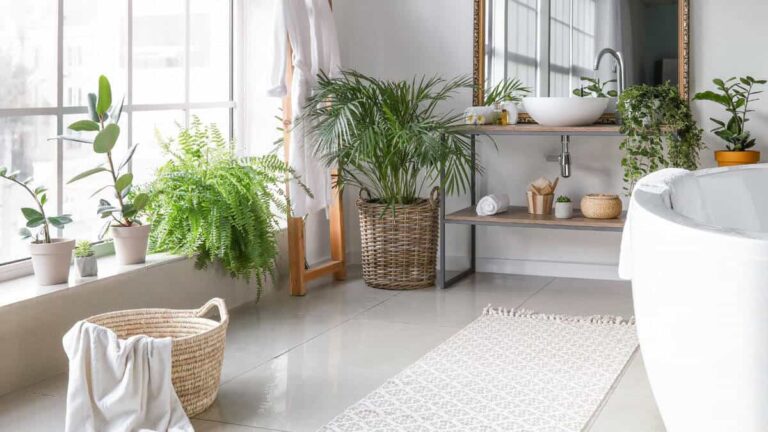Listen up guys, if you’ve been staring at that outdated bathroom with the peeling wallpaper and that weird stain in the corner that nobody talks about… but you have absolutely no clue where to start and your savings account is giving you the side-eye.
I’ve got you covered! Today I’m walking you through 10 super practical tips for a stress-free bathroom renovation that won’t make you want to pull your hair out.
These ideas will help you create a bathroom you actually want to spend time in without losing your mind or emptying your wallet in the process. Ready? Let’s jump in!
Hi everyone! If this is your first time here, I will write about making home transformation simple and painless, especially for people who’ve never picked up a tile cutter before.
Stick around because we’re going to make your bathroom renovation journey way less scary than you think.
Keep reading to the end because I’m sharing the one tip that consistently saves my readers thousands of dollars when they’re working with tight budgets.
It transforms their space without requiring professional skills!
How To Do Stress-Free Bathroom Renovation
Renovating your bathroom doesn’t have to give you gray hairs.
The secret sauce to keeping things calm is proper preparation, realistic expectations, and making smart choices before you ever pick up a hammer.
Let’s break down these ten tips that will make your renovation journey much smoother.
Start With a Clear Plan
Jumping into a bathroom renovation without a plan is like trying to bake a cake without a recipe – you might end up with something, but it probably won’t be what you wanted!
A clear plan works as your roadmap through the renovation journey.
When creating your plan, don’t just think about how you want things to look – think about how you actually use your bathroom day-to-day.
Are you a long-shower person? Do you need extra counter space for your skincare routine? Do multiple people use the bathroom at once?
Try drawing your bathroom layout on paper or use one of those free design apps.
Mark where everything will go and how much space you’ll need to move around comfortably.
Having a visual helps you catch problems before they happen – like realizing your dream clawfoot tub would leave you shimmying sideways just to reach the sink!
The best plans also include a rough timeline and a checklist of all materials you’ll need to buy.
This prevents those “oh no” moments three weeks in when you realize you forgot to order that pebble tile for the shower niche.
Set a Realistic Budget
Money stress can ruin even the prettiest bathroom renovation.
Being honest about what you can afford from day one keeps the whole project more enjoyable.
When creating your budget, break everything down into categories: demolition, plumbing, electrical, materials, fixtures, and labor.
Research actual costs – don’t just guess! Call suppliers, check online, and ask friends who’ve done similar projects.
Always, always add 20% extra for surprises.
Trust me, when you open up those bathroom walls, you might find things that make you go “yikes!” You want to avoid plumbing problems when renovating by having that financial cushion ready for the unexpected pipe issues or water damage that might be hiding behind your walls.
A smart budget trick? Pick one or two splurge items that really matter to you (maybe that rainfall showerhead you’ve been dreaming about), then save on other elements.
Home makeover improvement stores often have sales around holidays – timing your purchases around these can stretch your dollars further.
Choose the Right Layout
Your bathroom layout can make or break how functional the space feels, regardless of how pretty your tile choices are.
The right layout maximizes the space you have while making the bathroom feel bigger and more functional.
Think about traffic flow – can people move around easily? Is there a clear path to the toilet, shower, and sink without awkward shuffling?
For tiny bathrooms, consider space-saving fixtures like corner sinks, pocket doors, or shower stalls instead of tubs.
In larger spaces, you have more freedom but still need to think about what makes sense for daily use.
Measure everything twice! And I mean everything – the dimensions of your bathroom, the size of new fixtures, the swing space for doors and drawers.
Those pretty vanities look much less attractive when you can’t fully open the bathroom door because they stick out too far.
Prioritize Quality Over Trends
Bathroom trends come and go faster than you can say “subway tile,” but quality installations last decades.
When planning your renovation, think about which elements need to stand the test of time versus where you can have some fun.
Plumbing fixtures, basement waterproofing, and tile installation should never be places where you cut corners.
That gorgeous but poorly installed shower will quickly lose its charm when water starts leaking into your downstairs ceiling!
But what about those bold trends you love? My rule: make trendy choices on elements that are relatively easy and inexpensive to replace later. Paint color? Easy to change.
Funky light fixtures? Simple swap. Complete marble shower in this year’s “it” pattern? Maybe reconsider.
Quality doesn’t always mean the most expensive option.
Research brands known for durability and good warranty policies.
Read reviews from real people who’ve lived with products for a while, not just those who are excited about their brand-new bathroom.
Hire Trusted Professionals
Unless you’ve got serious DIY skills, some parts of bathroom renovation really need professional help.
Finding the right people makes all the difference between stress and success.
Good professionals aren’t just skilled at their craft – they communicate clearly, show up when promised, and clean up after themselves.
Ask friends for recommendations, read online reviews, and always check credentials and insurance.
Before hiring anyone, get at least three quotes and make sure they’re detailed.
Vague estimates often lead to surprise costs later. Ask for a timeline too – how long will each stage take?
Always get everything in writing! A proper contract protects both you and the contractor and helps prevent miscommunications.
And don’t be afraid to speak up if something doesn’t look right during the work – catching problems early is always easier than fixing them later.
Focus on Proper Ventilation
Ventilation might sound boring compared to picking pretty tiles, but it’s actually super important for keeping your new bathroom in good shape.
Good ventilation prevents mold, mildew, peeling paint, and warped cabinets.
It also keeps your bathroom smelling fresh, which is a nice bonus! Your fan needs to be properly sized for your bathroom space – too small and it won’t do its job effectively.
Look for quiet fans (measured in sones) so you’re not annoyed every time it runs.
And consider models with humidity sensors that automatically turn on when needed.
Position your fan where it will be most effective – usually near the shower or tub.
Connect your fan to a timer switch so it continues running for 20-30 minutes after you leave the bathroom.
This helps remove all the lingering moisture that causes problems down the road.
Plan for Storage Solutions
Nothing ruins the zen of a beautiful new grey white bathroom faster than clutter with nowhere to go.
Smart storage planning keeps your space functional and peaceful.
Before finalizing any designs, make a list of everything you need to store in your bathroom – from towels to toothpaste to that collection of half-used hotel shampoos you can’t seem to part with.
Then make sure your renovation plan includes enough space for all of it.
Built-in storage like recessed medicine cabinets, shower niches, and vanity drawers maximize space without creating visual clutter.
Vertical storage makes use of wall space when floor space is limited.
One clever hack: look for “dead spaces” that could be repurposed, like the area above the toilet or unused corners.
Custom-built shelving or cabinets in these spots can add storage without making the room feel cramped.
Don’t Rush the Timeline
I know you want your new bathroom done yesterday, but rushing almost always leads to mistakes, stress, and sometimes even higher costs.
A realistic timeline accounts for each phase of the renovation: demolition, rough-in work (plumbing and electrical), walls and waterproofing, tile installation, fixture installation, and finishing touches.
Each step needs proper time, and some steps need drying or curing time before the next can begin.
Weather, material delays, and contractor schedules can all impact your timeline.
Building in buffer days helps keep small delays from cascading into major schedule problems.
A renovation that takes a bit longer but is done right will always be better than a rushed job you’ll need to fix later.
Using a simple calendar or project management app to track progress can help you stay organized without getting overwhelmed.
Being patient isn’t easy when you’re sharing one bathroom or using your in-laws’ shower, but the quality results are worth it!
Pay Attention to Lighting
Great lighting can make an okay bathroom look amazing, while poor lighting can make even the most expensive renovation look flat and uninviting.
Bathroom lighting needs to serve multiple purposes – task lighting for shaving or applying makeup, ambient lighting for a relaxing bath, and maybe accent lighting to highlight special features.
Layering these different types creates a flexible, functional space.
Position lights to minimize shadows on faces when using the mirror.
Sconces on either side of the mirror work better than a single light above, which casts unflattering shadows.
Don’t forget natural light! If you have a window, maximize it with a clear glass treatment that maintains privacy while letting light through.
If privacy isn’t a concern, consider a larger window or even a skylight for dramatic natural illumination.
Light bulb choice matters too.
LED lights save energy and last longer, but make sure to choose bulbs with a color temperature that flatters skin tones (around 2700K-3000K works well in bathrooms).
Double-Check Before Finalizing
The final walk-through before considering your renovation complete might seem tedious, but it saves so much headache down the road.
Create a detailed checklist of everything that should be working properly: Do all faucets turn on and off smoothly? Are there any leaks under sinks or around fixtures? Do drawers and cabinets open fully without hitting anything? Does the toilet flush completely? Is all the caulking neat and complete?
Test everything thoroughly. Run the shower at full pressure.
Fill the tub and drain it. Turn on the fan and make sure it’s pulling air (hold a tissue near it – it should pull toward the vent).
Check that all electrical outlets work and that GFCIs trip properly when tested.
Look at the finishes in different lighting conditions too – what looks perfect in morning light might reveal flaws in evening light.
Taking this time to identify any issues while contractors are still on the job saves you from trying to get them back weeks later when you discover a problem.
Conclusion
Renovating your bathroom doesn’t have to be a nightmare! With proper planning, realistic expectations, and these ten tips, you can navigate the process with way less stress and end up with a bathroom you truly love.
Remember that perfection is rarely possible, but functionality and beauty absolutely are.
Take your time, make thoughtful choices, and don’t be afraid to ask questions along the way.
What’s your biggest concern about starting a bathroom renovation? Drop a comment below – I love hearing from readers and helping where I can! Until next time, happy renovating!



